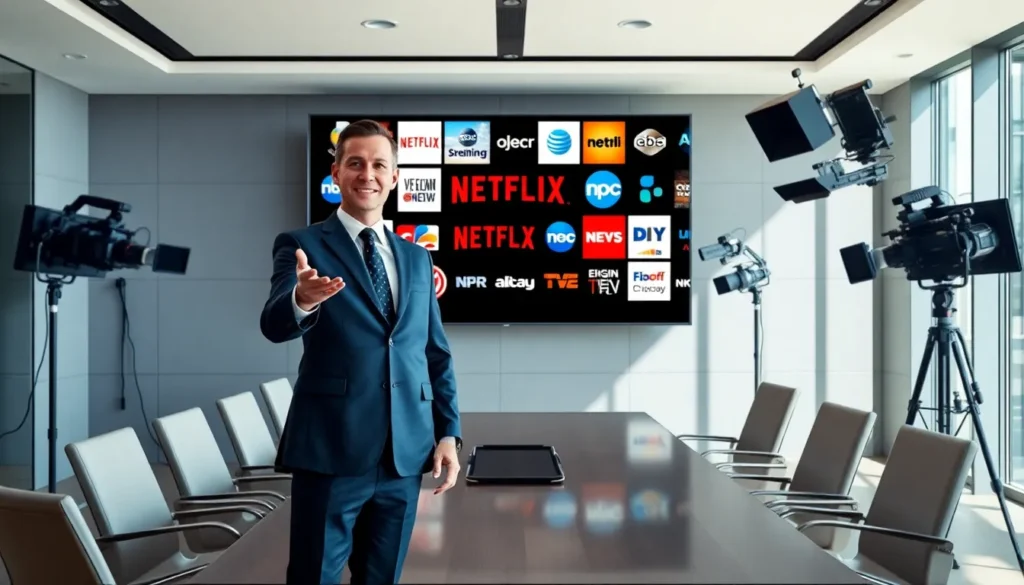Table of Contents
ToggleWhen was the last time you settled into your couch, remote in hand, only to find yourself bombarded by advertisements? Ah, the joys of broadcast media advertising. With its glittering allure and reach, broadcast media has stood the test of time, capturing the attention, and wallets, of millions. It’s like the grandparent of digital marketing, still relevant even as we scroll through endless social feeds. So, why does broadcast advertising still matter? Buckle up, because we’re diving deep into its intricacies, benefits, and future.
Understanding Broadcast Media Advertising

Broadcast media advertising encompasses a variety of strategies aimed at promoting products or services through television and radio channels. While social media and digital platforms often grab the spotlight, broadcast media remains a powerhouse, capable of reaching vast audiences in a matter of seconds. Think about it: just one compelling advertisement can reach millions, creating an immediate impact. By harnessing the power of sight, sound, and motion, advertisers have crafted narratives that resonate with viewers and listeners alike.
The history of broadcast media advertising goes back to the early 20th century, evolving with technology and audience preferences. Advertising in this medium allows companies to showcase their brand with vibrant visuals and catchy jingles. In essence, it’s not just about selling: it’s about storytelling, creating an emotional connection that can lead to brand loyalty.
The Types of Broadcast Media
Broadcast media advertising primarily falls into two categories: television and radio. Each medium has distinct characteristics and advantages.
Television Advertising
Television has long been considered the gold standard in advertising. Whether it’s prime time shows or popular sports events, TV ads can leave a lasting impression. Think Super Bowl commercials, they’re practically an event all their own. Advertisers can leverage visuals, sounds, and engaging narratives to capture attention. Plus, with the rise of streaming services, the way advertisements are delivered has evolved, think targeted ads based on viewer preferences.
Radio Advertising
On the other hand, radio advertising offers unique benefits too. It’s often more affordable than television. With carefully crafted messages and jingles, radio spots can engage listeners, even during their morning commute. Not to mention, radio can create a more intimate atmosphere, fostering a sense of familiarity and trust with the audience. The flexibility in scheduling allows for reach during peak drive times, making it a solid choice for local businesses.
The Role of Target Audiences in Broadcast Advertising
Understanding your target audience is crucial in the realm of broadcast advertising. Advertisers must know who they’re trying to reach before putting a single second of airtime on the clock. Identifying demographics such as age, gender, lifestyle, and interests helps to shape the tone and content of the advertisement. An ad aimed at teenagers will differ significantly from one targeting senior citizens.
Also, capturing the attention of the right audience can enhance brand recall and connection. Tailoring ads in this manner can drive engagement: a carefully targeted message feels personal and relevant. Companies investing in research to analyze viewer patterns and preferences are often the ones reaping the most benefits.
Strategies for Effective Broadcast Media Advertising
To maximize the effectiveness of broadcast media advertising, implementing strategic approaches is vital. Here are several tried-and-true strategies:
1. Compelling Storytelling
Creating a captivating narrative is essential. Stories resonate deeply with audiences and are more likely to be remembered than plain facts. Advertisers should aim to present a situation that sparks emotions, whether that be joy, nostalgia, or even humor.
2. Clear Call to Action
Every advertisement should conclude with a strong call to action. This prompts viewers to take that next step. Whether it’s visiting a website or making a purchase, clarity is key. It’s all about guiding the audience toward their next move.
3. Consistency Across Platforms
Cross-promoting messages across different media ensures consistency in branding. When audiences see the same messaging on TV, radio, and online platforms, it reinforces brand identity and builds trust.
4. Timing Matters
Understanding peak viewing and listening times can significantly impact ad effectiveness. An ad during the Super Bowl reaches millions, but it may also be beneficial to strategize ads around shows that resonate more with a target demographic.
Measuring Success in Broadcast Advertising
Success in broadcast media advertising can be quantified through various metrics. Evaluating the return on investment (ROI) is crucial. Advertisers should analyze factors such as:
1. Reach and Frequency
Measure how many people were exposed to the advertisement and how often. High reach with adequate frequency can amplify ad recall.
2. Consumer Response
Engagement levels can be assessed through surveys, social media interaction, or web traffic changes post-campaign. This informs whether the ad effectively resonates with its target audience.
3. Sales Metrics
Eventually, increased sales volume or market share can effectively demonstrate the success of an advertising campaign. Tracking sales before, during, and after the ad run provides a reality check on effectiveness.
The Future of Broadcast Media Advertising
The landscape of broadcast media advertising is evolving rapidly. With the growth of digital platforms and streamlining services, advertisers must adapt to stay relevant. The blending of traditional and digital advertising is on the rise. Expect to see more integrated campaigns featuring interactive elements, like ads accompanied by social media engagement opportunities.
Also, advancements in technology are paving the way for smarter ad placements. Data-driven strategies will enable more precise targeting, which enhances personalization. Artificial intelligence and automation in advertising are making the process more efficient, allowing advertisers to fine-tune their messaging in real-time based on audience feedback.




